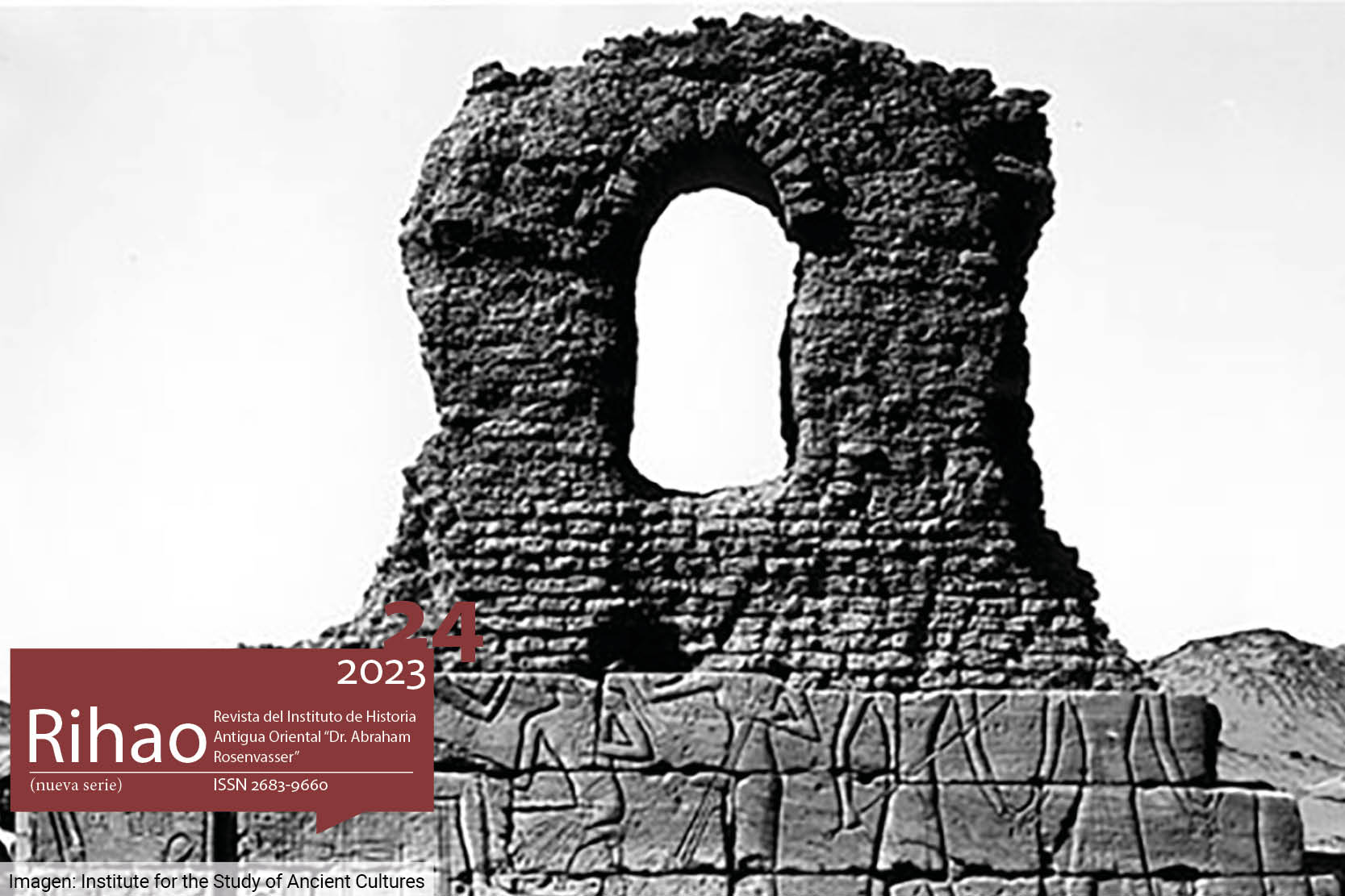Ofrendas para el Más Allá. Una propuesta de análisis de la puerta de acceso a la capilla en la tumba de Amenmose (TT 318)
Resumo
Este artículo tiene como objetivo proporcionar un análisis interpretativo de la puerta de entrada a la capilla o sala interior de la tumba tebana 318 (TT 318). Esta tumba, ubicada en Sheikh Abd el-Qurna, perteneció a un cantero/trabajador de la necrópolis de Amón, llamado Amenmose, que vivió en la dinastía XVIII, durante los reinados de Hatshepsut y Tutmosis III. El pasaje que une la sala transversal con la capilla consta de un dintel y dos jambas, los cuales contienen textos con fórmulas de ofrendas para el ka del difunto y escenas de adoración de Amenmose, junto con su esposa, a Anubis y a las diosas de Oriente y Occidente. El estudio del dintel y sus jambas, junto con sus textos, nos ha permitido definir dicho pasaje como un espacio liminal e interpretar los textos de sus jambas a partir de un modelo de lectura basado en un patrón de circulación interna del monumento.Downloads
Não há dados estatísticos.
Referências
Allen, J. (2011). The debate between a man and his soul: a masterpiece of ancient Egyptian literature (Culture and History of the Ancient Near East 44). Leiden: Brill.
Antoniadou, C. (2018). Anubis: The God’s Manifestation in the Iconographical and Literary Sources of the Pharaonic Period. Postgraduate Dissertation. Rodas: University of the Aegean.
Arnold, D. (2003). The Encyclopaedia of Ancient Egyptian Architecture. Translated by Sabine H. Gardiner and Helen Strudwick. Londres: I. B. Tauris.
Barta, W. (1968). Aufbau und Bedeutung der altägyptischen Opferformel. Glückstadt: J. J. Augustin.
Bryan, B. (2009). Memory and Knowledge in Egyptian Tomb Painting, en: Cropper, E. (ed.), Dialogues in Art History, from Mesopotamian to Modern: Readings for a New Century. Washington: National Gallery of Art, 19-39.
Dodson, A. e Ikram, S. (2008). The Tomb in Ancient Egypt: Royal and Private Sepulchres from the Early Dynastic Period to the Romans. Londres: Thames & Hudson.
Engelbach, R. (1924). A Supplement to the Topographical Catalogue of the Private Tombs of Thebes (Nos. 253 to 334) with Some Notes on the Necropolis From 1913 to 1924. El Cairo: Printing Office of the French Institute of Oriental Archaeology.
Hartwig, M. (2004). Tomb painting and identity in ancient Thebes, 1419-1372 BCE. Bruselas / Turnhout: Fondation Égyptologique Reine Élisabeth / Brepols.
Ikram, S. (2009). Ancient Egypt: An Introduction. Cambridge: Cambridge University Press.
Kampp, F. (1996). Die thebanische Nekropole: zum Wandel des Grabgedankens von der 18. bis zur 20. Dynastie (Theben 13). Maguncia: Zabern.
Kampp-Seyfried, F. (2003). The Theban necropolis: an overview of topography and tomb development from the Middle Kingdom to the Ramesside period, en: Strudwick, N. y Taylor, J. H. (eds.), The Theban necropolis: past, present and future. Londres: British Museum Press, 2-10.
LÄ = Helck, W. y Otto, E. (eds. vol. I); Helck, W. y Westendorf, W. (eds. vols. II-VII). (1975-1992). Lexikon der Ägyptologie, 7 vols. Wiesbaden: Harrassowitz.
Leitz, C. (ed.) (2002). Lexikon der ägyptischen Götter und Götterbezeichnungen, 8 vols. (Orientalia Lovaniensia Analecta 110-116, 129). Lovaina: Peeters.
Manniche, L. (1987). City of the dead: Thebes in Egypt. Londres: British Museum Publications.
Manzi, L., Yomaha, S. y Zingarelli, A. (2022). Informe de la primera campaña en la tumba de Amenmose (TT318), Luxor-Egipto, en: Revista del Museo de Antropología 15 (3): 33-48.
McQuinn, Z. (2011). Immortal visages in the Diniacopoulos Collection: a statue group from Theban Tomb 318, en: Francis, J. E. y Harrison, G. W. M. (eds.), Life and death in ancient Egypt: the Diniacopoulos Collection. Montreal: Concordia University, 68-72.
Meyer-Dietrich, E. (2010). Recitation, Speech Acts, and Declamation, en: Wendrich, W. (ed.), UCLA Encyclopedia of Egyptology. Los Ángeles: UCLA. En línea: http://escholarship.org/uc/item/1gh1q0md. [Consultado: 30-11-2021].
Pamminger, P. (1991). Das Trinken von Überschwemmungswasser: eine Form der jährlichen Regeneration des Verstorbenen, en: Göttinger Miszellen 122: 71-75.
Porter, B. y Moss, R. (1960). Topographical bibliography of ancient Egyptian hieroglyphic texts, reliefs, and paintings. Vol. 1: The Theban Necropolis. Part 1: Private Tombs. Oxford: Griffith Institute.
Refai, H. (1996). Die Göttin des Westens in den thebanischen Gräbern des Neuen Reiches: Darstellung, Bedeutung und Funktion (Abhandlungen des Deutschen Archäologischen Instituts Kairo, Ägyptologische Reihe 12). Berlín: Achet.
Robins, G. (2010). Space and movement in pre-Amarna Eighteenth Dynasty Theban tomb chapels, en: Woods, A., McFarlane, A. y Binder, S. (eds.), Egyptian culture and society: studies in honour of Naguib Kanawati, vol. 2. El Cairo: Conseil Suprême des Antiquités, 129-142.
Roeten, L. (2021). Doors, entrances and beyond…: various aspects of entrances and doors of the tombs in the Memphite necropoleis during the Old Kingdom (Archaeopress Egyptology 33). Oxford: Archaeopress.
Taylor, J. (2001). Death and the Afterlife in Ancient Egypt. Londres: British Museum Press.
Antoniadou, C. (2018). Anubis: The God’s Manifestation in the Iconographical and Literary Sources of the Pharaonic Period. Postgraduate Dissertation. Rodas: University of the Aegean.
Arnold, D. (2003). The Encyclopaedia of Ancient Egyptian Architecture. Translated by Sabine H. Gardiner and Helen Strudwick. Londres: I. B. Tauris.
Barta, W. (1968). Aufbau und Bedeutung der altägyptischen Opferformel. Glückstadt: J. J. Augustin.
Bryan, B. (2009). Memory and Knowledge in Egyptian Tomb Painting, en: Cropper, E. (ed.), Dialogues in Art History, from Mesopotamian to Modern: Readings for a New Century. Washington: National Gallery of Art, 19-39.
Dodson, A. e Ikram, S. (2008). The Tomb in Ancient Egypt: Royal and Private Sepulchres from the Early Dynastic Period to the Romans. Londres: Thames & Hudson.
Engelbach, R. (1924). A Supplement to the Topographical Catalogue of the Private Tombs of Thebes (Nos. 253 to 334) with Some Notes on the Necropolis From 1913 to 1924. El Cairo: Printing Office of the French Institute of Oriental Archaeology.
Hartwig, M. (2004). Tomb painting and identity in ancient Thebes, 1419-1372 BCE. Bruselas / Turnhout: Fondation Égyptologique Reine Élisabeth / Brepols.
Ikram, S. (2009). Ancient Egypt: An Introduction. Cambridge: Cambridge University Press.
Kampp, F. (1996). Die thebanische Nekropole: zum Wandel des Grabgedankens von der 18. bis zur 20. Dynastie (Theben 13). Maguncia: Zabern.
Kampp-Seyfried, F. (2003). The Theban necropolis: an overview of topography and tomb development from the Middle Kingdom to the Ramesside period, en: Strudwick, N. y Taylor, J. H. (eds.), The Theban necropolis: past, present and future. Londres: British Museum Press, 2-10.
LÄ = Helck, W. y Otto, E. (eds. vol. I); Helck, W. y Westendorf, W. (eds. vols. II-VII). (1975-1992). Lexikon der Ägyptologie, 7 vols. Wiesbaden: Harrassowitz.
Leitz, C. (ed.) (2002). Lexikon der ägyptischen Götter und Götterbezeichnungen, 8 vols. (Orientalia Lovaniensia Analecta 110-116, 129). Lovaina: Peeters.
Manniche, L. (1987). City of the dead: Thebes in Egypt. Londres: British Museum Publications.
Manzi, L., Yomaha, S. y Zingarelli, A. (2022). Informe de la primera campaña en la tumba de Amenmose (TT318), Luxor-Egipto, en: Revista del Museo de Antropología 15 (3): 33-48.
McQuinn, Z. (2011). Immortal visages in the Diniacopoulos Collection: a statue group from Theban Tomb 318, en: Francis, J. E. y Harrison, G. W. M. (eds.), Life and death in ancient Egypt: the Diniacopoulos Collection. Montreal: Concordia University, 68-72.
Meyer-Dietrich, E. (2010). Recitation, Speech Acts, and Declamation, en: Wendrich, W. (ed.), UCLA Encyclopedia of Egyptology. Los Ángeles: UCLA. En línea: http://escholarship.org/uc/item/1gh1q0md. [Consultado: 30-11-2021].
Pamminger, P. (1991). Das Trinken von Überschwemmungswasser: eine Form der jährlichen Regeneration des Verstorbenen, en: Göttinger Miszellen 122: 71-75.
Porter, B. y Moss, R. (1960). Topographical bibliography of ancient Egyptian hieroglyphic texts, reliefs, and paintings. Vol. 1: The Theban Necropolis. Part 1: Private Tombs. Oxford: Griffith Institute.
Refai, H. (1996). Die Göttin des Westens in den thebanischen Gräbern des Neuen Reiches: Darstellung, Bedeutung und Funktion (Abhandlungen des Deutschen Archäologischen Instituts Kairo, Ägyptologische Reihe 12). Berlín: Achet.
Robins, G. (2010). Space and movement in pre-Amarna Eighteenth Dynasty Theban tomb chapels, en: Woods, A., McFarlane, A. y Binder, S. (eds.), Egyptian culture and society: studies in honour of Naguib Kanawati, vol. 2. El Cairo: Conseil Suprême des Antiquités, 129-142.
Roeten, L. (2021). Doors, entrances and beyond…: various aspects of entrances and doors of the tombs in the Memphite necropoleis during the Old Kingdom (Archaeopress Egyptology 33). Oxford: Archaeopress.
Taylor, J. (2001). Death and the Afterlife in Ancient Egypt. Londres: British Museum Press.
Publicado
2023-12-01
Como Citar
Rosell, P. M. (2023). Ofrendas para el Más Allá. Una propuesta de análisis de la puerta de acceso a la capilla en la tumba de Amenmose (TT 318). Revista Del Instituto De Historia Antigua Oriental ’Dr. Abraham Rosenvasser’, (24). https://doi.org/10.34096/rihao.n24.13748
Edição
Seção
Dossier. Egiptología iberoamericana (primera parte)





.jpg)







